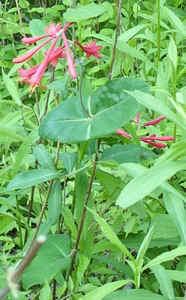 |
Common Name: Coral Honeysuckle, Trumpet Honeysuckle, Scarlet Honeysuckle, Mailbox Honeysuckle
Scientific Name: Lonicera sempervirens
Family: Caprifoliaceae
Native
White Oak Mountain
Polk County, North Carolina
May 8, 2002
 |
A glabrous, twining vine, with the opposite leaves just below the inflorescence fused around the stem. The united petals form a slender trumpet-shaped flower nearly 2 inches long. These perennials, sometimes cultivated, are native to the southeastern states and grow in clearings and along the margins of deciduous woodlands in our coastal plain and piedmont. March - May [Justice, William S. and Bell, C. Ritchie, Wild Flowers of North Carolina. University of North Carolina Press, Chapel Hill, 1968]
This handsome woody vine is common in Shenandoah National Park but scarce in the mountains to the south. In the Great Smokies it is believed to be an escape from cultivation. The opposite oval leaves are dark green above and pale beneath; the upper 1 or 2 pairs are united and appear to be pierced by the stem. Slender, trumpet-shaped flowers appear in late April or May, arranged in 2 or 3 whorls. The little trumpets, 1 - 1 1/2 inches long, are a bright scarlet on the outside and yellow within. The fruit is a small red berry. This slender twining vine, also called "coral honeysuckle", grows in woods and along fence rows at the lower altitudes. [Stupka, Arthur, Wildflowers in Color. HarperPerennial, A Division of HarperCollins Publishers, New York, 1965]
One of the first plants to sustain hummingbirds on their journey north in the spring is coral or scarlet honeysuckle. The thin trumpet-shaped blooms hang in large clusters, providing a banquet for weary avian travelers. This native vine covers a fence steadily but slowly, unlike the romping, invasive Japanese honeysuckle that chokes woodlands and borders over the entire East. The genus name Lonicera honors Adam Lonitzer (1528-1586), a German herbalist. Sempervirens is from the Latin, meaning "ever-living". In the middle to lower south, where the leaves of this vine can be evergreen, it is commonly planted at the base of mailboxes, giving it the common name, mailbox honeysuckle. [Midgley, Jan. W., Southeastern Wildflowers. Cranehill Publishers, Hong Kong, 1999]
January February March April May June July August September October November December
Alphabetical Listings -- A B C D, E F G H I, J, K L M N, O P Q, R S T U, V W X, Y, Z
Family Listings -- A B C D, E F G H I, J, K L M N, O P Q, R S T U, V W X, Y, Z
Genus Listings -- A B C D, E F G H I, J, K L M N, O P Q, R S T U, V W X, Y, Z